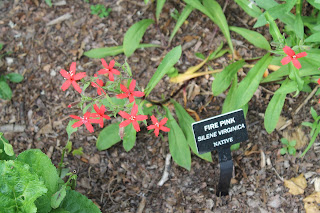 The far Coastal Plain of South Carolina offers many beautiful places; long
sandy beaches, emerald coastal forest and massive live oak trees with broad
spreading crowns. These are ancient trees draped in pale Spanish moss that
embody the Deep South. In the distance cabbage palmettos dot the landscape.
Botanically there's no place in the world that looks like this. It's entirely
unique to the south eastern United States. A splash of subtropical ecosystem
near it's northern limit. Tucked into this magical woodland only a half hour
south of Myrtle Beach, Brookgreen Gardens draws the casual visitor, artists,
nature lovers and avid public garden enthusiast.
The far Coastal Plain of South Carolina offers many beautiful places; long
sandy beaches, emerald coastal forest and massive live oak trees with broad
spreading crowns. These are ancient trees draped in pale Spanish moss that
embody the Deep South. In the distance cabbage palmettos dot the landscape.
Botanically there's no place in the world that looks like this. It's entirely
unique to the south eastern United States. A splash of subtropical ecosystem
near it's northern limit. Tucked into this magical woodland only a half hour
south of Myrtle Beach, Brookgreen Gardens draws the casual visitor, artists,
nature lovers and avid public garden enthusiast.Archer and Anna Hyatt Huntington of Connecticut purchased four plantations to open the garden and showcase her sculptures in the 1929. At the bringing of the long stately entrance road off coastal highway 17 the huge Fighting Stallions sculpture hints at the experience to come. This is one of Anna's largest works. As a public garden one might expect a space made up of various plant collections; there is certainly that at Brookgreen. Indeed many beautiful ornamental gardens expand around ponds, pools and court yards. But Brookgreen is also one of countries great sculpture gardens. Dozens of sculptures large and small highlight the Gardens core. Some are truly monumental. The golden sculpture on Dionysus is simply stunning rising from the Rosen Carolina Terrace. Nearby, the Brown Sculpture Court is formal space replete with a rectangular reflecting pool. A short stroll north the Poetry Garden appears neatly laid out in four quadrants featuring literature inspired sculpture. Overall more than 1400 sculptures by 350 artist are on display at Brookgreen.
Entering the Live Oak Allee one might expect to encounter Rhett Butler puffing on a slim cigar while smoke dances about the humid air. Looking east down the Allee one can spy Diana of the Chase in a circular pool, her bow drawn skyward. In the core of Brookgeen is a magical mix of monumental sculpture among the grand trees and shrubs that embody a remarkably rich textured space. Sculpture classes and training also take place at Brookgreen. The Offner Sculpture Learning and Research center is a beautiful space. Sculpture Gardens can be overwhelming to the botanically focused plant purist. Yet, the art of horticulture often mixes with sculpture in magical and unique ways. Botanical gardens the world over frequently include sculptures. Combining Brookgreen's extensive sculpture collections in a sub-tropical lowcountry landscape reveals a unique national treasure.
Beyond the regal sculpture, outer areas of the garden mix with an extensive wetland of the Waccamaw and nearby Great Pee Dee Rivers. Here you can take a delightful pontoon boat tour into the classic lowcountry wetland. These coastal lowlands offer exceptional birding and wildlife viewing. alligators, river otters, snakes and beavers can be found among shallow circuitous channels, islands and bays. Many estuarial grasses dot the water providing perfect habitat for birds and aquatic life of all kinds.
At the far north eastern corner of the garden a small zoo featuring native animals is another hidden treat on the expansive grounds of Brookgreen. Near the zoo entrance is the Floyd Domestic Animals of the Plantation exhibit. This unique feature does a great job of interpreting the amazing contributions of domestic animals to colonial agriculture. Without whom modern agricultural would never have advanced.
Not surprisingly Brookgreen's extensive property was once four large rice plantations. As such, the site was used for the sale, exchange and imprisonment of humans. Not a pretty spectacle under any circumstance. Joshua John Ward who owned Brookgreen plantation was the nation’s largest slave holder with nearly 1900 people in his service. Slaveries long-term brutality can be difficult to interpret given the ownership of people as an economic commodity on pre-war plantations. But Brookgreen makes every effort to interpret slavery on the site as part of the properties history. A special garden educational program in the Gullah Geechee series profiles the arrival enslaved West Africans on the plantation.
Other areas of the Garden worth seeing abound in an attractive mosaic of semi-open woodlands and fields. The areas near Jessamine Pond and Magnolia Allee offer peaceful open acres to stroll among the beautifully keep grounds. At the far backside of the walled gardens a trial leads to a viewing platform and a meditative labyrinth on the wetlands edge. Beyond all these features Brookgreen boast a cafe, restaurant, butterfly house and a well-appointed welcome center.
Traveling south from the near endless commercialism of Myrtle Beach one can feel the relief as the woodlands return and the coastal lowcountry expands. Passing through picturesque Murrells Inlet, Brookgreen is on the right; you can't miss the Fighting Stallions towering above the highway. Over the years Brookgreen has been recognized as a National Historic Landmark and added to National Register of Historic Places. As a public garden Brookgreen is nationally unique. Plan a half or whole day to experience this extraordinary cultural and historic attraction.




